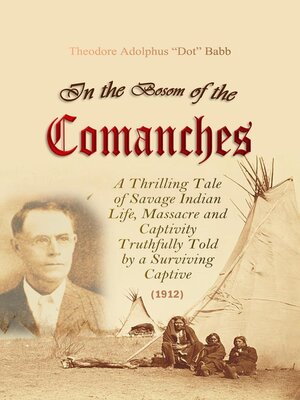In the Bosom of the Comanches
ebook ∣ A Thrilling Tale of Savage Indian Life, Massacre and Captivity Truthfully Told by a Surviving Captive (1912)
By Theodore Adolphus "Dot" Babb

Sign up to save your library
With an OverDrive account, you can save your favorite libraries for at-a-glance information about availability. Find out more about OverDrive accounts.
Find this title in Libby, the library reading app by OverDrive.



Search for a digital library with this title
Title found at these libraries:
| Library Name | Distance |
|---|---|
| Loading... |
"The 14-year-old white boy developed a taste for raids and battles." -The Captured (2007)
"Death, flight, or capture were the alternatives faced by youth on the Texas frontier during Dot Babb's boyhood. Dot saw all of these in operation by fiendish Comanches." - Children Indian Captives (1980)
"'Dot' Babb, was abducted by Comanche Indians in Texas and later became their spokesman." - Babb Unabridged (2015)
"Chief Horseback ... reluctantly agreed to the ransoming of ... Dot Babb ... for several horses, bridles, blankets, saddles, and other goods." - Comanches in the New West (1999)
"When Dot Babb was ransomed in his early teens, his Comanche foster mother and brother were very sad." - The Last Comanche Chief (1996)
"Babb's experience as a captive among the Comanches represents a markedly different type of experience than Rachael Plummer's." - Comanches and Texans in the Making of the Comanche Nation (1997)
The stories of those Texas pioneers who survived captivity among the Comanches are full of harrowing interest. Of particular interest is that told by Dot Babbs in his 1912 narrative, "In the Bosom of the Comanches."
In 1865, a time in Texas when keenest vigil day and night was never relaxed by man or beast, when the horizon was anxiously scanned for the ascending camp fire smoke, swirling clouds of dust or other such unfailing portents of the "red messengers of devastation and death," the fierce Comanches raided the homestead of 13-year-old Theodore Adolphus "Dot" Babb (1852-1936), killing his mother, and capturing Dot, his little sister, and the visiting Widow Luster. After pillaging the place, the Comanches with their prisoners fled the area to avoid any pursuit, eventually reaching the Canadian river, where they camped.
After the Widow Luster attempted escaped at night, Babb relates that as revenge the Comanches "made signs to me that they were going to riddle me with bullets and arrows and then take my scalp and have a big war dance over it." "Cooler heads" prevailed and instead the Comanches "took a raw-hide rope and tied me to the tree. They then pulled long dead grass and collected a lot of dry brush from the nearby trees and placed all around me, preparatory to cremating me alive ... and then held what seemed a last council."
However, as Babb relates, "my seeming total lack of fear and utter defiance of the most painful of deaths evidenced the qualities and courage needful in a warrior, and as such they spared my life and attached or adopted me as a prospective militant tribesman."
In his enforced captivity by the Comanches, one of the fiercest tribes then extant, Dot Babb approached his maturing years as a full-fledged warrior, being made to engage in raids and battles in common with the Comanche braves. His experiences, privations, and exploits are recounted with the simplicity and vividness of truth in his 1912 book "In the Bosom of the Comanches."







